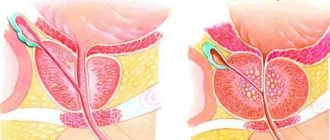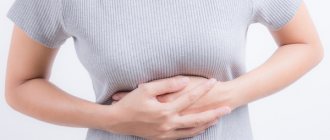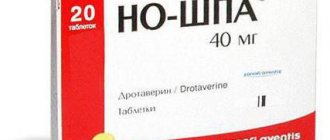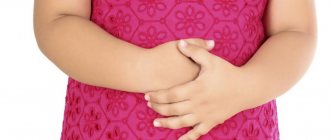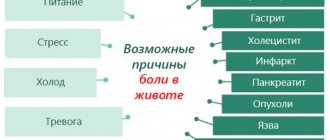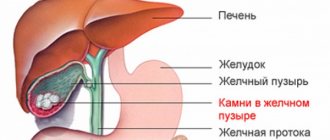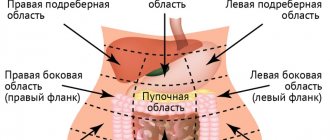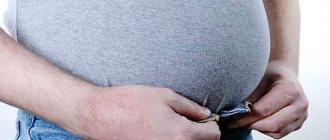When the symptoms are not dangerous
If your stomach hurts after exercise, you need to rest for a couple of hours.
If pain appears immediately after physical activity, you need to give the child a rest. The cramps will go away within 1-2 hours. The pain in this case is associated with muscle overstrain and the production of lactic acid.
Another reason is overeating or consuming large amounts of sweets and soda. Then mild poisoning may develop. You need to monitor your future health.
A 5 year old child has a stomach ache: first aid
If the occurrence of pain is associated with a violation of the diet, then parents should treat this more carefully: do not allow the child to drink carbonated drinks, salty foods, or raw milk.
Your first aid kit should always contain medications that help with abdominal pain. For example, for intestinal bloating, you can give Disflatil or Espumisan.
If a feeling of severe pain appears some time after eating, then the following medications can be given - Festal, Mezim. If diarrhea occurs, Lactovit, Smecta, Linex will help.
After taking such drugs, it is possible to eliminate some disturbances in the functioning of the intestines that arose due to food. But if the pain lasts more than two to three hours, and its symptoms are pronounced, then of course it’s worth talking about calling an ambulance. It is possible that the baby will have to be hospitalized.
Pathologies that cause pain in the lower abdomen
The most common deviation is acute food poisoning. Children often encounter it in schools, kindergartens, camps and other public places. In case of poisoning, the central part of the lower abdomen hurts, diarrhea appears, and sometimes vomiting and fever develop.
Dyspeptic disorders
Dyspepsia occurs due to insufficient production of digestive and intestinal enzymes. Among its symptoms:
- pain in the side of the abdomen (on the left side);
- spontaneous vomiting or nausea;
- diarrhea after every meal.
Dyspeptic deviation requires complex treatment in order to restore the microflora and normalize the production of enzymes.
Colic and other conditions in infants
It is quite difficult to accurately determine the area of pain in newborn babies. Their common complaints are: crying, irritability, twitching of limbs, refusal to eat. This indicates the development of colic. They are often associated with an incorrect diet of the mother or the introduction of complementary foods.
The most dangerous condition is volvulus. It is found most often in bottle-fed babies. Symptoms include lack of passing gas and stool. Sometimes infants experience vomiting, fever, and feces may be expelled in small portions containing blood. This is a dangerous condition that requires emergency medical attention.
Diseases of children over 1 year of age
In preschoolers, painful sensations can develop against the background of emotional stress. Very often, children 5-7 years old develop irritable bowel syndrome, which is characterized by:
- alternating diarrhea and constipation;
- reduction of pain after bowel movement;
- Feeling better after a long break from studying and doing other things.
Another reason is abdominal migraine, which develops due to severe cramps. As it progresses, it turns into a regular headache. There are usually no other symptoms, and the pain goes away after a short sleep.
Specific diseases in schoolchildren
Children over 10-11 years of age may experience special conditions. Girls at this age may begin to menstruate, which is accompanied by nagging pain. Sometimes they encounter cystitis, the symptoms of which are quite distinct: pain and burning when urinating, increased urge, fever. Gynecological diseases develop less frequently.
In boys at this age, cystitis is also possible, depending on childhood prostatitis and intestinal diseases. The pain is sharp, sudden, colic of the reproductive system and even bleeding may appear.
Appendicitis, which often occurs in adolescents between 12 and 18 years old, cannot be ruled out. With it, the pain is usually located on the right, and can begin from above or below.
Pain in the lower abdomen in children from 0 to 18 years of age is associated with diseases of the digestive system, genitourinary organs, and less often with other disorders. But sometimes it is a consequence of banal experiences and physical exertion.
Causes of abdominal pain and accompanying symptoms
Abdominal pain can be short-term and long-lasting, sharp and weak, in the area near the stomach or throughout the abdomen, but the main rule in this situation is that you cannot wait until the pain becomes unbearable, and unless it is heaviness from eating too much , you need to call a doctor immediately.
The most common causes of abdominal pain in a child:
- Colic
They usually affect infants up to 3-4 months old. The baby draws in his legs, starts screaming, spins and tenses. The pain is relieved by placing a heated diaper on the stomach or drinking dill water. You can try carrying the baby in a column. For particularly excruciating pain, when the child does not sleep at night, the pediatrician prescribes a special medicine. For example, Espumisan, Bobotik, Plantex. (how to help a baby with colic)
- Constipation
In this case, colic is also accompanied by bloating. Usually you can’t do without an enema (how to give an enema to a newborn baby) or a special suppository (glycerin or sea buckthorn). (constipation in a newborn - how to help)
- Crick
It manifests itself in the form of sharp and sharp pain while walking or when trying to sit up straight. It is the result of severe physical strain and sometimes appears after vomiting or severe coughing. Apart from pain, nothing bothers the child, he has a normal appetite and is in normal condition.
- Intestinal obstruction
Characteristic of infants aged 5–9 months. Requires urgent contact with a surgeon. Associated symptoms are nausea, vomiting, blood in the stool.
- Flatulence (bloating) and accumulation of gases
The child becomes capricious and nervous, sleeps poorly. During feeding, the baby may greedily grab the breast or pacifier and then suddenly spit it out. After feeding, regurgitation and belching may be observed. Quite often, flatulence is a sign of other more serious conditions.
- Worms
Usually these are roundworms. The pain is not as acute as with colic or constipation, but it appears regularly. Additional symptoms are headaches, flatulence, itching in the anus. It is a mistake to believe that grinding your teeth in a dream is associated with worms in the body.
- Intolerance to any product
Lactose intolerance (milk and dairy products) is most common in children. Malaise begins 30 - 40 minutes after consuming the product. In addition to pain, the child suffers from bloating, diarrhea, and sometimes vomiting. The pain is of the nature of colic or spasms.
- Jaundice
The disease is quite serious and contagious. Severe pain is localized in the liver area. The sclera of the child's eyes turn yellow, and the urine takes on a dark tint. The disease requires emergency medical attention. (jaundice in newborns)
- Inflammation of the testicles
Usually the child feels pain in the lower abdomen, radiating from the scrotum. Inflammation can be caused by testicular torsion, hernia, or ordinary bruise. It is important to provide qualified medical care.
- Pyelonephritis
This disease is typical for girls. Acute and quite severe pain is localized in the lower back, side, and lower abdomen. They are usually accompanied by fever, headache, weakness, increased sweating, chills, nausea and vomiting. The disease is very serious, it is caused by inflammation of the renal pelvis. The cause may be bacteria entering the urinary system or an obstruction in the flow of urine from the kidneys. The disease can be treated with medication, but in particularly severe situations there is no other option other than surgical intervention.
- Gastroenteritis
The disease is characterized by inflammation of the lining of the stomach and small intestine caused by viruses, parasites or bacteria. The pain is paroxysmal, dull. Additional symptoms are rumbling in the stomach, diarrhea, nausea, vomiting, fever. At the slightest suspicion of gastroenteritis, you should immediately consult a pediatrician.
- Appendicitis
Appendicitis is an inflammation of the appendage of the cecum, called the appendix. It usually occurs in 1 in 6 children. And until two years of age, as a rule, it does not worsen. Most often, children aged 8 to 14 years are susceptible to the disease. At first, a dull aching pain in the right or lower abdomen, loss of appetite, weakness, vomiting, and fever are typical. Then sharp cutting pains occur and perforation of the appendix wall quickly develops. All its contents pass into the peritoneum, which poses a serious risk to the child’s life. This cannot be done without urgent surgery. (appendicitis)
Symptoms for urgently calling an ambulance
- For a child under 5 years old, the pain does not go away for more than 3 hours. The baby is capricious and nervous.
- Abdominal pain is accompanied by rashes on the child’s skin or inflammation of the joints.
- Abdominal pain is accompanied by diarrhea, fever, severe nausea or persistent vomiting.
- The pain is localized in the umbilical area.
- The child refuses food and water due to abdominal pain.
- Severe abdominal pain after a fall or blow to the stomach.
- The pain is accompanied by weakness, pallor, and loss of consciousness.
- The pain occurs at night.
- Abdominal pain and lack of stool.
- Regular pain lasting more than 2 weeks.
- Frequent abdominal pain and weight loss (or developmental delays).
- Frequent pain that recurs regularly over several weeks/months (even in the absence of other symptoms).
Dr. Komarovsky tells us when a child urgently needs a doctor for abdominal pain:
When to see a doctor right away
A child needs emergency medical attention if additional symptoms appear. An interesting feature of pain in the lower abdomen is due to the fact that the nerve endings in this area can react to irritation located far away - in the upper abdomen and even in the lungs. You need to call an ambulance in the following cases:
- pain intensifies over several hours;
- unbearable nausea and repeated vomiting occur;
- temperature rises;
- stool disorder appears.
This condition is difficult to determine only by the symptoms that the baby describes. Sometimes it is difficult for a child to say exactly what is bothering him. Especially when an infant is sick.
It is forbidden to give your child painkillers if any symptom appears. It is important to monitor his condition throughout the day. Cold compresses and hot heating pads are prohibited aids.
Abdominal pain in young children
The most difficult thing to diagnose is pain in the lower abdomen in a small child, especially in an infant, since he simply cannot complain about his health. However, the baby can give several signals, and if the parents notice them, then they definitely need to suspect something is wrong.
These “calls” include:
- the child constantly cries and even screams;
- the baby refuses to eat;
- regurgitation became more frequent, vomiting appeared;
- the child’s sweating has increased, or vice versa – his skin has become dry and hot;
- the baby looks lethargic and reluctantly reacts to external stimuli.
If these symptoms are detected, parents should press very gently and gently on the baby's tummy. If at the same time he begins to behave even more restlessly and starts crying, then there is no doubt that his stomach hurts.
Most often, discomfort in the lower abdomen in infants occurs during the introduction of complementary foods or a complete transition to artificial formula. This is real stress for the baby’s digestive system, and it quickly reacts to a change in diet with intestinal colic. In this case, if an infant has pain in the lower abdomen, you should either completely abandon the new product, or introduce it very slowly, literally a quarter spoon at a time.
Alas, even newborn babies have serious diseases of the abdominal organs that require urgent medical intervention. Even at such a young age, appendicitis, inflammation of Meckel's diverticulum and intussusception can develop. If the baby’s condition only worsens, you need to call an ambulance as quickly as possible.
First aid for a child with abdominal pain
If the parents called an ambulance or a local therapist to their home, but the child is in too much pain, you can get a preliminary consultation with a doctor about first aid. It usually comes down to the following steps if it is a newborn:
- the child's belly is massaged clockwise;
- hold the baby in your arms only vertically, placing his stomach is prohibited;
- for acute colic, place the baby on his back and press his knees to his stomach;
- on the recommendation of a doctor, you can give a water infusion of dill.
Older children may be advised to lie on their side and tuck their legs. It is strictly forbidden to wrap a child of any age in a blanket, give enemas for diarrhea and give laxatives. You should also not feed your baby. If appendicitis or intestinal obstruction is suspected, even water should not be given.
For chronic gastritis and other pathologies that do not require emergency medical or surgical care, you can relieve your baby of cramps with decoctions of mint, chamomile, and lemon balm. In case of poisoning, you should rinse your stomach with a soda solution (1 tablespoon per cup of boiled water).
It is recommended to give an electrolyte solution only in case of severe diarrhea, strictly following the instructions. It is advisable to provide therapeutic fasting for at least 12 hours.
A 5 year old child has a stomach ache: how to treat it
You cannot independently prescribe medications to treat abdominal pain in a child. However, there are several safe medications that can relieve your baby of abdominal pain.
Gastrolit, Regidron
If, along with pain, the child vomits and has diarrhea, then you need to take saline solutions. As a result of vomiting and diarrhea, the body will lose fluid, and this threatens intoxication and dehydration. After taking these medications, the body’s water balance will be restored, and it will also be saturated with the necessary minerals.
Enterosgel Smecta
Smecta is the best drug for removing toxins and bacteria from the stomach and intestines in case of poisoning of a child. But this drug will not stop diarrhea, but gas formation and bloating will be reduced. The drug Enterosgel has exactly the same effect as Smecta.
Forte, Hilak, Linex, Enterol
Probiotics and prebiotics can restore intestinal microflora. The drugs have antiviral and antimicrobial effects. They are used to treat poisoning, intestinal infections and diarrhea.
Diet
If you have abdominal pain, you need to adhere to a certain diet. For example, if your baby is constipated, you need to include juices and fruits (apples, pears, apricots) in his diet. Cereal porridges and fermented milk products are beneficial.
But if a child has diarrhea, then the diet will be completely different. In order to restore your water balance, you need to drink frequently. You can eat rice porridge, broths, low-fat soups.
Important! If, along with pain, the child vomits several times, postpone meals for a while. Let him drink boiled water, often, but little by little.
To prevent your baby from developing colic, you need to exclude the following:
1. Don't give him too heavy or fatty foods.
2. Limit sweets.
3. Sauerkraut and grapes are not recommended.
4. Also exclude fast food, carbonated drinks, and preservatives.
Many mothers often ask which doctor they should contact if their child has abdominal pain. First of all, of course, you need to visit a pediatrician in order to identify the cause of the pain, and also get a referral for tests. Depending on the results, your pediatrician will refer you to one of the following doctors:
• psychiatrist;
• cardiologist;
• infectious disease specialist;
• gastroenterologist;
• rheumatologist.
Parents should under no circumstances ignore problems with their child’s stomach, as this could be a manifestation of serious illnesses.
Methods for diagnosing and treating diseases
The most common method of instrumental diagnosis is ultrasound.
The disease can be detected only through instrumental examination. For this, parents and their child contact a pediatrician. Next, the doctor, analyzing the existing symptoms, prescribes a consultation with another specialist. This could be a urologist, gastroenterologist or gynecologist.
To determine the pathology, you will need to donate blood, urine, feces, and take a smear. Ultrasound and x-rays are also prescribed. In difficult cases or when complex pathologies are suspected, MRI or CT is prescribed.
If a child has pain in the lower abdomen, parents should remember the main rule of treatment - only after consulting a doctor. Kids react much faster to medications and incorrect actions. Using hardware methods, the doctor will determine the cause of the disease, study the test results and prescribe adequate therapy.
Treatment will consist of medications, in most cases for children. They will also prescribe physiotherapeutic procedures, recommend a nutrition plan and physical activity (PT). A course of antibiotics may be required.
If the pathology is associated with physiological processes, for example, the onset of menstruation in girls, the doctor may recommend safe antispasmodics. However, it is not recommended to give them to children.
Prevention of pain
The best way to prevent unpleasant sensations is to maintain a healthy lifestyle and control the child’s nutrition. It is very important that he understands the harm and danger of chips, soda and store-bought sweets. You should also teach your child that physical education is a good thing and should be done regularly.
Parents should monitor the baby’s health and consult a doctor if there are any symptoms of pathology. Timely diagnosis and treatment is a way to prevent complications and unpleasant symptoms.
